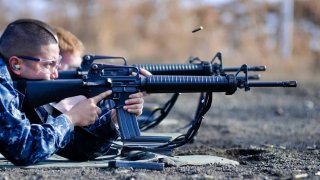British Military Trials Next-Generation Body-Worn Technology to Enhance Soldier Survivability
The British military has completed trials for a next-generation body-worn technology aimed at enhancing frontline troops' survivability and situational awareness. The new gear includes a laser detection system to alert soldiers if they are targeted, drone thermal detection for identifying enemy threats, and ground sensors for detecting approaching foes.
Summary and Key Points: The British military has completed trials for a next-generation body-worn technology aimed at enhancing frontline troops' survivability and situational awareness. The new gear includes a laser detection system to alert soldiers if they are targeted, drone thermal detection for identifying enemy threats, and ground sensors for detecting approaching foes.
-Additional technologies tested include a helmet-mounted strobe alert system, advanced digital day/night optics for weapons, a mesh network to extend radio range, and a smart hub for integrated power and data supply.
-These advancements, developed in collaboration with the Defense Science and Technology Laboratory (Dstl) and industry partners, aim to provide UK Armed Forces with superior operational capabilities and battlefield awareness.
Revolutionizing Soldier Gear: UK's New Body-Worn Tech Targets Modern Battlefield Challenges
The British military is planning a new body-worn kit with impressive new technologies for its soldiers.
The new gear is designed to deal with the new realities of the modern battlefield and help counter drones and laser detection, among other things.
Next Generation Body Kit
The British military just completed a set of trials to test a next-generation body-worn technology for its frontline troops. The overall goal of the technology is to increase soldiers’ survivability by enhancing their situational awareness and decisionmaking capabilities.
Some of the technologies that were tested and might become operational in the future include a laser detection system to warn a troop if an enemy has located them, a drone thermal detection system to identify enemy soldiers and weapon systems in the area, and ground sensors that can detect approaching enemies and alert allied soldiers.
“This government is clear in our commitment to advancing technology that ensures the safety and superiority of UK Armed Forces. This cutting-edge technology will bolster operational lethality and elevate battlefield awareness. I welcome the continued collaboration between government, industry, and scientists on this innovative programme,” Minister for Defence Procurement and Industry Maria Eagle said.
Other technologies include a helmed-mounted strobe alert system that identifies friend from enemy; advanced digital day/night optics for weapons; a mesh network that connects a troop’s radio with other radios in the vicinity, thus increasing range; and a smart hub that acts as the “brain” of the integrated power and data supply for all digital devices.
The testing was conducted by troops from the 2nd Battalion, the Royal Anglian Regiment and scientists from the Defense Science and Technology Laboratory (Dstl).
“This technology will protect the lives of our Armed Forces by improving operational capability by giving them the advantage over the enemy,” Jon Russell, a senior principal scientist at Dstl said about the next-generation systems.
“It is great to see the Future Integrated Dismounted Soldier Vision is clearly proving how a soldier system containing multiple knowledge capabilities that are designed to combine crucial data to improve operational advantage,” Russell added.
“Our aim is to develop the most capable armed forces in the world, by merging different technologies to advance battlefield awareness,” he concluded.
The fighting in Ukraine has shown that militaries need to evolve when facing a superior adversary. Drones, electronic warfare, and guided artillery are dominating the fighting in Ukraine. As such, soldiers need the right countermeasures and defense against these new threats.
“The trial, led by Dstl, was a showcase of future technologies and digital integration. The research has now advanced, bringing together industry to enhance capabilities with Command, Control, Communications, Computing and Information Systems,” the regimental sergeant major of the infantry trials and development unit said about the new gear.
“As the Army’s lead in dismounted close combat trials and development, we are at the forefront of improving operational advantage and look forward to supporting its future development,” he added.
The U.S. military has been working on a similar project to modernize the basic loadout of its infantrymen so that they can be more effective on the modern battlefield.
About the Author
Stavros Atlamazoglou is a seasoned defense journalist specializing in special operations and a Hellenic Army veteran (national service with the 575th Marine Battalion and Army HQ). He holds a BA from Johns Hopkins University and an MA from Johns Hopkins’ School of Advanced International Studies (SAIS). His work has been featured in Business Insider, Sandboxx, and SOFREP.


